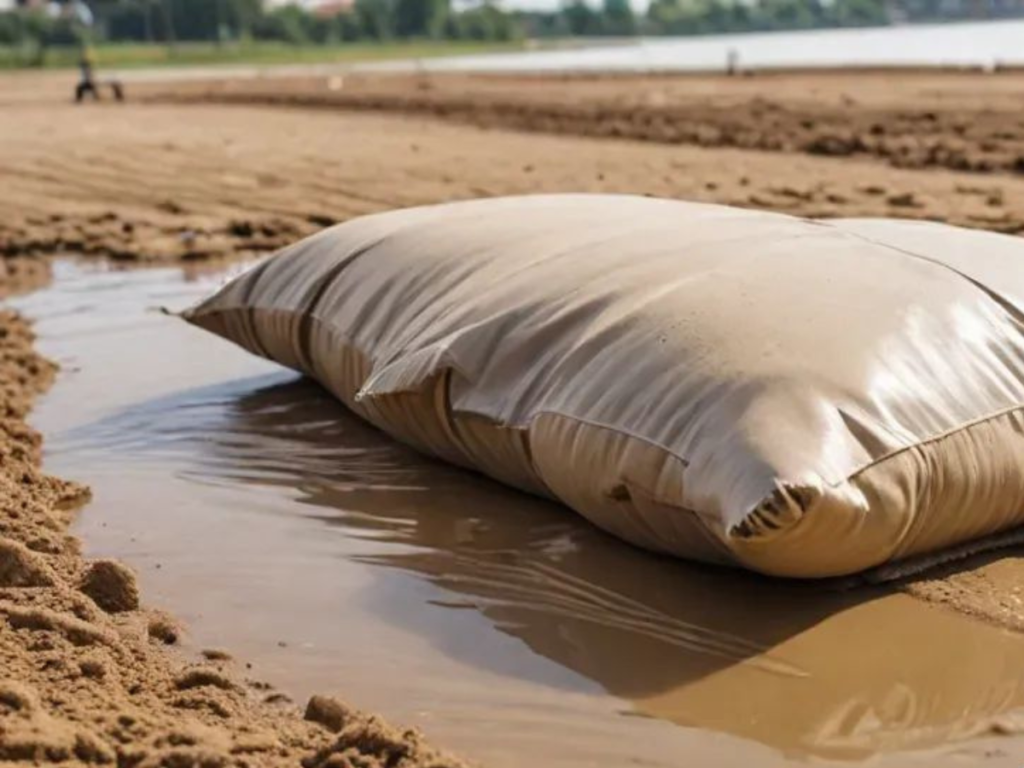When floods threaten, one of the most common and reliable defenses is the humble sandbag. But have you ever wondered why sand is the material of choice to fill these bags?
Let’s dive into the basics of sandbags, their role in flood protection, and even some advancements in sandbag technology.
By the end of this blog, you’ll understand why sand is the go-to filler and appreciate the critical role sandbags play in keeping our homes and communities safe from rising waters.
Basics of Sandbags
Sandbags are essentially just bags filled with sand or similar materials. These bags can be made of various materials, but the most common is a durable, woven polypropylene. When stacked properly, sandbags create a formidable barrier against floodwaters.
Simple Yet Effective
The concept behind sandbags is simple: they act as a physical barrier to block and divert the flow of water. Despite their simplicity, they are incredibly effective at what they do. When floodwaters rise, sandbags can be quickly deployed to protect homes, businesses, and critical infrastructure.
Versatility
Sandbags are versatile and can be used in various configurations depending on the situation. They can be stacked to create walls, used to reinforce existing structures, or placed in strategic locations to direct water away from vulnerable areas.
Why Sand?
So, why is sand the preferred material for filling sandbags? Let’s explore the reasons behind this choice.
Density and Weight
Sand is heavy. This weight is crucial because it helps sandbags stay in place even when they are subjected to the force of flowing water. The density of sand means that when a sandbag is placed on the ground, it forms a stable barrier that doesn’t easily shift or get washed away.
Flexibility
Despite its weight, sand is also relatively flexible. This flexibility allows sandbags to conform to the surface they are placed on, creating a better seal against the ground. This adaptability helps prevent water from seeping through or around the sandbags.
Availability and Cost
Sand is abundant and relatively inexpensive. During a flood emergency, large quantities of sand can be quickly sourced and transported to the affected area. This availability makes sand an ideal material for rapid response in flood situations.
Non-Absorbent
Unlike other materials that might absorb water and become waterlogged, sand remains relatively non-absorbent. This property ensures that the sand inside the bags doesn’t become saturated and loses its effectiveness as a barrier.
Role of Sandbags
Sandbags play a crucial role in flood defense. Let’s delve deeper into how they function and why they are so important.
Building Temporary Barriers
The primary role of sandbags is to build temporary barriers to hold back floodwaters. These barriers can be constructed quickly and adapted to the specific needs of the situation. For example, a single row of sandbags might be sufficient to keep water out of a door, while a stacked wall might be needed to protect a larger area.
Diverting Water
Sandbags are also used to divert water away from critical areas. By strategically placing sandbags, flood response teams can channel water away from homes, roads, and infrastructure, minimizing damage.
Reinforcing Existing Structures
In addition to creating new barriers, sandbags can be used to reinforce existing structures. For example, sandbags can be placed against the sides of buildings, levees, or dikes to provide extra strength and stability against rising water levels.
Providing Psychological Comfort
While it might seem less tangible, sandbags also provide a significant psychological benefit. Knowing that sandbags are in place can give residents and business owners a sense of security and control in the face of a flood.
Advancements in Sandbags
While the basic concept of sandbags has remained largely unchanged for centuries, there have been some advancements in sandbag technology that have improved their effectiveness and ease of use.
Self-Inflating Sandbags
One of the most notable advancements is the development of self-inflating sandbags. These bags contain a super-absorbent polymer that expands when exposed to water. This innovation eliminates the need for sand, making deployment quicker and less labor-intensive. These bags can be stored flat and only take on their full weight and effectiveness when needed.
Improved Materials
Advances in materials have also led to more durable and resilient sandbags. Modern sandbags are often made from high-strength, UV-resistant fabrics that can withstand prolonged exposure to sunlight and harsh weather conditions without degrading.
Pre-Filled Sandbags
To speed up deployment during emergencies, pre-filled sandbags are now available. These sandbags are filled with sand or other materials in advance and can be quickly transported to the site of a flood. This can be particularly useful for emergency response teams who need to act fast.
Innovative Designs
Some companies are experimenting with new designs that improve the stability and effectiveness of sandbag barriers. For example, interlocking sandbags can create more stable walls that are less likely to be breached by water. Other designs focus on making sandbags easier to carry and stack.
Conclusion
The use of sandbags remains a cornerstone of flood defense due to their simplicity, effectiveness, and versatility. The choice of sand as the filling material is no accident; its density, flexibility, availability, and non-absorbent properties make it ideal for creating stable and reliable barriers against floodwaters.
Despite their long history, sandbags continue to evolve with advancements in materials and design, making them even more effective in protecting our communities from the devastating effects of flooding. Whether it’s traditional sand-filled bags or modern self-inflating versions, sandbags are an essential tool in our flood defense arsenal.
Understanding the basics of sandbags, their role in flood protection, and the advancements that are improving their performance helps us appreciate why these unassuming bags of sand are so vital. The next time you see sandbags being deployed in a flood, you’ll know just how crucial they are in keeping the water at bay and protecting our homes and lives.
So, whether you’re stacking them yourself or relying on emergency responders, sandbags play a pivotal role in flood defense.





